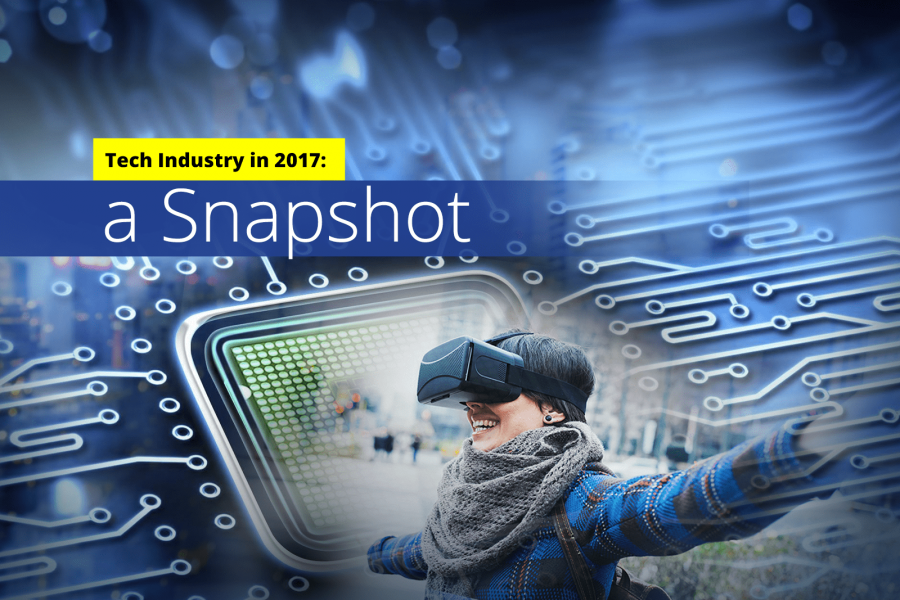
The meteoric rise of cryptocurrencies might have hogged the headlines, but 2017 was a whole lot more. In fact, the technology industry as a whole has had quite an eventful year.
From the acceleration of digital transformation across industries and the emergence of the kinetic enterprises, it’s impossible to cover everything for our snapshot of the tech industry in a single post.
But as 2017 comes to an end, let’s take a look at some of the key technology trends and innovations that have transformed the industry and could influence how businesses operate in the new year.
1. Kinetic Enterprise
No matter what industry you’re in, the speed at which technology upgrades and advances can feel overwhelming. This has made it imperative for enterprises to embrace this phenomenon.
According to Deloitte, this has created the kinetic enterprise where the only constant is change. However, while adapting to change is important, companies have to sift through the promotional noise to identify technologies that have the potential to offer real business value.
Once the right technologies are identified, businesses can become more kinetic, have enhanced dexterity and vision to realize their true potential through technology-fueled disruption.
2. The No-Collar Workforce
This year, we started seeing artificial intelligence (AI) gain traction as automation and cognitive technologies were incorporated into business operations. This trend is expected to continue and go through a period of acceleration in 2018.
In the near future, this will create a situation where enterprises will need to build hybrid working models and reinvent worker roles. This means assigning some tasks to humans and others to machines.
So the true potential of what started in 2017 will be realized next year when technology will augment human performance. However, this will present a whole new set of challenges for business leaders as they will have to find new innovative ways to simultaneously retrain augmented workers.
They will also have to develop new HR processes to effectively manage the following:
- AI-driven capabilities (comprising the no-collar workforce)
- Virtual workers
- Bots
- Cognitive agents
According to a survey of more than 1,850 global business leaders conducted by ServiceNow, as technology dramatically accelerates the volume of work, 86% of enterprises will need intelligent automation just to keep up by 2020.
At the same time, a no-collar workforce doesn’t mean fewer jobs will be created. While certain jobs that focus on repetitive mundane tasks will be eliminated, new jobs that demand a mix of skills will take their place.
In fact, 94% of business leaders surveyed agreed that when administrative tasks are automated, the demand will increase for soft skills jobs that require the following:
- Communication
- Collaboration
- Creative problem-solving
This year we also saw a rise in pay for jobs that used a lot of technology, so you can expect the same going forward.
3. Broader Adoption of the Blockchain
The blockchain is no longer the novel technology that made cryptocurrencies possible. This year we saw blockchain come of age and get incorporated across industries from finance to insurance to healthcare.
We also saw the emergence and rise of initial coin offerings and smart contracts in 2017 and we can expect to see more of this as businesses try to prepare for their next big opportunity by integrating, coordinating, and orchestrating several blockchains across the value chain.
4. Camera-Based Search
Your smartphone camera is better than it has ever been and it has already started to play a major role in our lives. But it has nothing to do with taking better selfies! Pretty soon, you will be able to point your camera at anything and get information about it in real-time (how cool is that?).
We saw the emergence of technology that leverages visual context about four years ago with QR Codes, but it didn’t really take off. However, in 2017 we now have technology giants like Apple, Facebook, Snapchat, and Venmo who have their own versions of it.
Next, you can expect camera-based search to take off and should change the way we find information. Both Google and Pinterest have launched their own version for specific types of camera-based searches and you can expect more of the same in 2018.
5. Real Business Value Lies in Getting Technology to Work Together
This year also saw several new technologies being called the “next big thing,” but for enterprises to derive the most business value, all these technologies need to work together in harmony and across domains.
Some of these new technologies like augmented reality, the blockchain, and AI have already started redefining business, IT, and society as a whole. But business leaders have found that treating these tools and capabilities independently, limited their impact.
So you can expect the focus of IT leaders in 2018 to switch to finding innovative ways to get these disruptive technologies to work together to achieve their operational and strategic goals.
6. Re-Engineering Technology
Every business is now a technology business because business strategies are inextricably linked to technology. This makes it imperative for companies to rethink how they explore, deliver, and advance their technology solutions.
As IT becomes the driving force of business growth, IT departments also took on new responsibilities this year. These new responsibilities span operations, back-office systems, and even platforms and products.
This phenomenon will lead to more digital transformation in 2018 as enterprises work to modernize their architecture stack, infrastructure, and revamp their methods for operating, organizing, and delivering technology capabilities.
This approach will not only make the organization more efficient, but it will also provide the tools and processes that will help redefine IT in the new year.
As the holiday season is upon us, we at Digi117 find ourselves reflecting on the past year and all those who have played a significant role in shaping our business. It’s been quite a year for us all!










